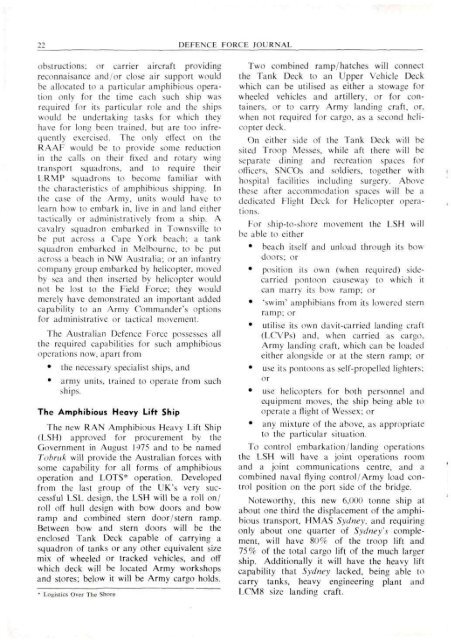ISSUE 1 : Nov/Dec - 1976 - Australian Defence Force Journal
ISSUE 1 : Nov/Dec - 1976 - Australian Defence Force Journal
ISSUE 1 : Nov/Dec - 1976 - Australian Defence Force Journal
Create successful ePaper yourself
Turn your PDF publications into a flip-book with our unique Google optimized e-Paper software.
22 DEFENCE FORCE JOURNALobstructions: or carrier aircraft providingreconnaisance and'or close air support wouldbe allocated to a particular amphibious operationonly for the time each such ship wasrequired for its particular role and the shipswould be undertaking tasks for which theyhave for long been trained, but are too infrequentlyexercised. The only effect on theRAAF would be to provide some reductionin the calls on their fixed and rotarv wingtransport squadrons, and to require theirLRMP squadrons to become familiar withthe characteristics of amphibious shipping. Inthe case of the Army, units would have tolearn how to embark in, live in and land eithertactically or administratively from a ship. Acavalry squadron embarked in Townsville tobe put across a Cape York beach; a tanksquadron embarked in Melbourne, to be putacross a beach in NW Australia; or an infantrycompany group embarked by helicopter, movedby sea and then inserted by helicopter wouldnot be lost to the Field <strong>Force</strong>; they wouldmerely have demonstrated an important addedcapability to an Army Commander's optionsfor administrative or tactical movement.The <strong>Australian</strong> <strong>Defence</strong> <strong>Force</strong> possesses allthe required capabilities for such amphibiousoperations now, apart from• the necessary specialist ships, and• army units, trained to operate from suchships.The Amphibious Heavy Lift ShipThe new RAN Amphibious Heavy Lift Ship(LSH) approved for procurement by theGovernment in August 1975 and to be namedTobruk will provide the <strong>Australian</strong> forces withsome capability for all forms of amphibiousoperation and LOTS* operation. Developedfrom the last group of the UK's very successfulLSL design, the LSH will be a roll on/roll off hull design with bow doors and bowramp and combined stern door/stern ramp.Between bow and stern doors will be theenclosed Tank <strong>Dec</strong>k capable of carrying asquadron of tanks or any other equivalent sizemix of wheeled or tracked vehicles, and offwhich deck will be located Army workshopsand stores; below it will be Army cargo holds.* Logistics Over The ShoreTwo combined ramp/hatches will connectthe lank <strong>Dec</strong>k to an I'pper Vehicle <strong>Dec</strong>kwhich can be utilised as either a stowage forwheeled vehicles and artillery, or for containers,or to carry Army landing craft, or.when not required for cargo, as a second helicopterdeck.On either side of the Tank <strong>Dec</strong>k will besited Troop Messes, while aft there will beseparate dining and recreation spaces forofficers, SNCOs and soldiers, together withhospital facilities including surgery. Abovethese after accommodation spaces will be adedicated Flight <strong>Dec</strong>k for Helicopter operations.For ship-to-shore movement the LSH willbe able to either• beach itself and unload through its bowdoors; or• position its own (when required) sidecarriedpontoon causeway to which itcan marry its bow ramp; or• 'swim' amphibians from its lowered sternramp; or• utilise its own davit-carried landing craft(LCVPs) and, when carried as cargo,Army landing craft, which can be loadedeither alongside or at the stern ramp; or• use its pontoons as self-propelled lighters;or• use helicopters for both personnel andequipment moves, the ship being able tooperate a flight of Wessex: or• any mixture of the above, as appropriateto the particular situation.To control embarkation/landing operationsthe LSH will have a joint operations roomand a joint communications centre, and acombined naval flying control/Army load controlposition on the port side of the bridge.Noteworthy, this new 6,000 tonne ship atabout one third the displacement of the amphibioustransport. HMAS Sydney, and requiringonly about one quarter of Sydney's complement,will have 80% of the troop lift and75% of the total cargo lift of the much largership. Additionally it will have the heavy liftcapability that Sydney lacked, being able tocarry tanks, heavy engineering plant andLC.M8 size landing craft.
















